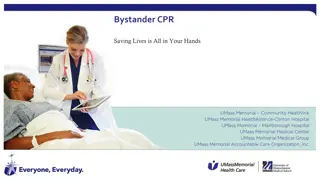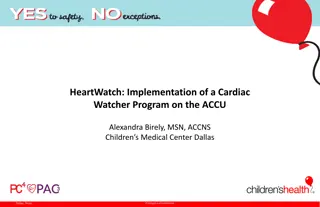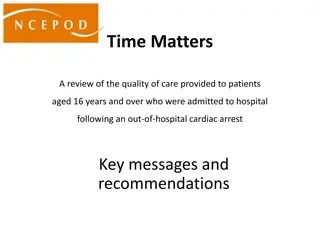Understanding Cardiopulmonary Resuscitation (CPR) and Cardiac Arrest
Cardiopulmonary resuscitation (CPR) is crucial in cases of cardiac arrest, a leading cause of death globally. Immediate recognition of symptoms such as unresponsiveness and abnormal breathing, early activation of emergency services, and prompt initiation of CPR can significantly improve survival rates. Early bystander CPR plays a vital role in doubling or quadrupling survival chances. Recognizing the signs, calling for help, and delivering CPR promptly are essential steps in the chain of survival for those experiencing cardiac arrest.
Download Presentation

Please find below an Image/Link to download the presentation.
The content on the website is provided AS IS for your information and personal use only. It may not be sold, licensed, or shared on other websites without obtaining consent from the author. Download presentation by click this link. If you encounter any issues during the download, it is possible that the publisher has removed the file from their server.
E N D
Presentation Transcript
Cardiopulmonary resuscitation
Cardiac arrest is a sudden stop in effective bloodflow due to the failure of the heart to contract effectively one of the leading causes of death in Europe 3 to 8 percent of all cardiac arrest victims survive to leave the hospital neurologically intact about 55 113 per 100,000 inhabitants a year or 350,000 700,000 individuals a year in Europe initial heart-rhythm analysis, about 25 50% of SCA victims have ventricular fibrillation (VF)
Cardiac arrest When the rhythm is recorded soon after collapse, in particular by an on-site AED, the proportion of victims in VF can be as high as 76% More victims of SCA survive if bystanders act immediately while VF is still present Successful resuscitation is less likely once the rhythm has deteriorated to asystole the recommended treatment for VF cardiac arrest is immediate bystander CPR and early electrical defibrillation
1.Early recognition and call for help CA- early recognition is critical to enable rapid activation of the EMS and prompt initiation of bystander CPR. The key observations are unresponsiveness and not breathing normally Cardiac arrest occurs in a quarter to a third of patients with myocardial ischaemia within the first hour after onset of chest pain- recognising the cardiac origin of chest pain, and calling the emergency services before a victim collapses, enables the emergency medical service to arrive sooner, hopefully before cardiac arrest has occurred - better survival
2. Early bystander CPR the immediate initiation of CPR can double or quadruple survival from cardiac arrest. bystanders with CPR training should give chest compressions together with ventilations bystanders without CPR training, the emergency medical dispatcher instructs him or her to give chest-compression-only CPR while awaiting the arrival of professional help
3. Early defibrillation within 3 5 min of collapse - survival rates as high as 50 70%. public access and onsite AEDs Each minute of delay to defibrillation reduces the probability of survival to discharge by 10 12%. when bystander CPR is provided, the decline in survival is more gradual, averages 3 4% per minute delay to defibrillation
4. Early advanced life support Advanced life support with airway management, drugs and correcting causal factors may be needed if initial attempts at resuscitation are unsuccessful
Dispatcher assisted CPR Dispatcher-assisted CPR (telephone-CPR) instructions have been demonstrated to improve bystander CPR rates, reduce the time to first CPR, increase the number of chest compressions and improve patient outcomes following out-of-hospital cardiac arrest (OHCA) in all patient groups. Dispatchers should provide telephone-CPR instructions in all cases of suspected cardiac arrest unless a trained provider is already delivering CPR for an adult victim, dispatchers should provide chest-compression-only CPR instructions. If the victim is a child, dispatchers should instruct callers to provide both ventilations and chest compressions
Chest compressions adults needing CPR - high probability of a primary cardiac cause. When blood flow stops after cardiac arrest, the blood in the lungs and arterial system remains oxygenated for some minutes. start with chest compressions rather than initial ventilations.
Chest compressions 1. Deliver compressions in the centre of the chest - on the lower half of the sternum 2. Compress to a depth of at least 5 cm but not more than 6 cm 3. Compress the chest at a rate of 100 120 per minute with as few interruptions as possible. 4. Allow the chest to recoil completely after each compression; do not lean on the chest.
Important notes Minimising pauses in chest compressions Delivery of rescue breaths, shocks, ventilations and rhythmanalysis lead to pauses in chest compressions. Pre- and post-shockpauses of less than 10 s - improved outcomes Pauses in chest com-pressions should be minimised, by ensuring CPR providers work effectively together. Firm surface CPR should be performed on a firm surface whenever possible.
Rescue breaths tidal volumes of approximately 500 600 mL (6 7 mL kg 1) are delivered - this is the volume required to cause the chest to rise visibly an inflation duration of about 1 s, with enough volume to make the victim s chest rise, but avoid rapid or forceful breaths. The maximum interruption in chest compression to give two breaths should not exceed 10 s
Rescue breaths Mouth-to-nose ventilation may be considered if the victim s mouth is seriously injured or cannot be opened, the CPR provider is assisting a victim in the water, or a mouth-to-mouth seal is difficult to achieve. Mouth-to-tracheostomy ventilatilation may be used for a victim with a tracheostomy tube or tracheal stoma who requires rescuebreathing.
Compressionventilation ratio mathematical model suggests that a ratio of 30:2 provides the best compromise between blood flow and oxygen delivery.
Compression only CPR all CPR providers should perform chest compressions for all victims in cardiac arrest CPR providers trained and able to perform rescue breaths should combine chest compressions and rescue breaths. The addition of rescue breaths may provide additional benefit for children, for those who sustain an asphyxial cardiac arrest, or where the emergency medical service (EMS) response interval is prolonged. studies of chest-compression-only CPR have shown that arterial oxygen stores deplete in 2 4 min If the airway is open, occasional gasps and passive chest recoil may provide some air exchange.
Use of an automated external defibrillator CPR should be continued while a defibrillator or AED is being brought on- site and applied, but defibrillation should not be delayed any longer. CPR providers should continue CPR with minimal interruption of chest compressions while attaching an AED and during its use. CPR providers should concentrate on following the voice prompts immediately when they are spoken, in particular resuming CPR as soon as instructed, and minimizing interruptions in chest compression pre-shock and post-shock pauses in chest compressions should be as short as possible Chest compressions should be paused every two minutes to assess the cardiac rhythm (shockable- VF/non shockable- A, PEA)
Resuscitation of children and victims of drowning children do not receive resuscitation because potential CPR providers fear causing harm if they are not specifically trained in resuscitation for children it is far better to use the adult BLS sequence for resuscitation of a child than todo nothing Give 5 initial rescue breaths before starting chest compressions Give CPR for 1 min before going for help in the unlikely event the CPR provider is alone. Compress the chest by at least one third of its depth; use 2 fingers for an infant under one year; use 1 or 2 hands for a child over 1year as needed to achieve an adequate depth of compression























